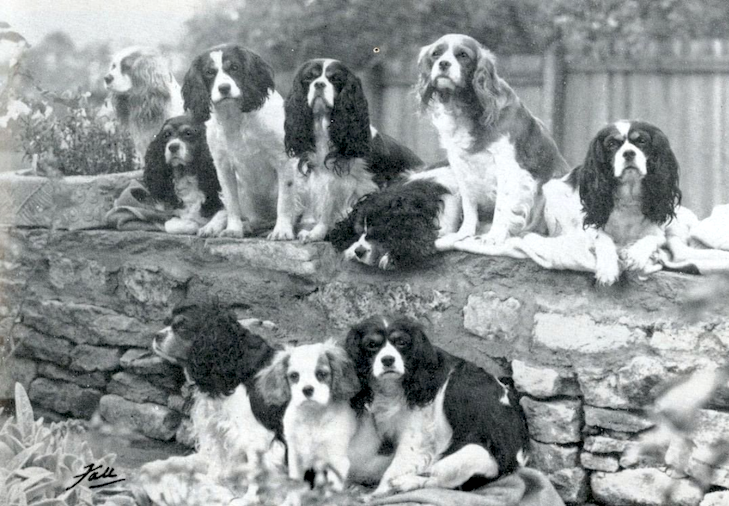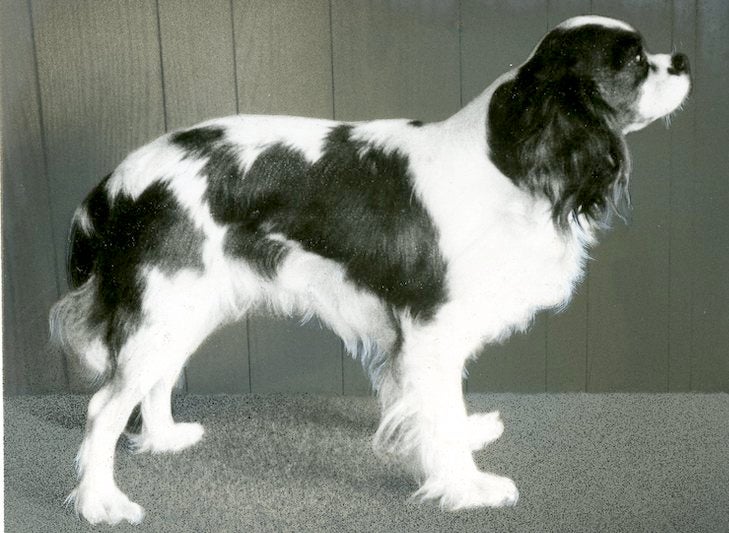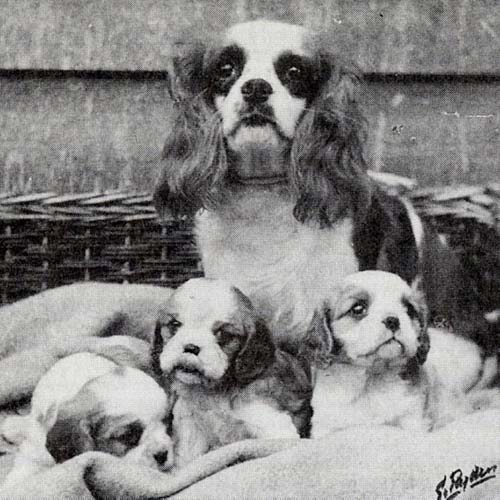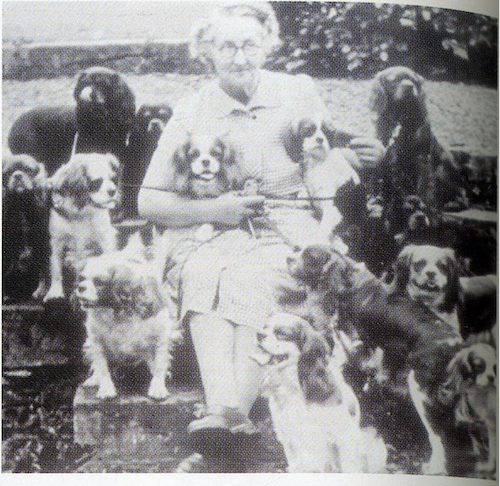
In 1926, Roswell Eldridge placed an ad in a dog-show catalog that dared British breeders to bring a royal breed back from the brink of extinction.
“Blenheim Spaniels of the Old Type, as shown in pictures of Charles II’s time, long face, no stop, flat skull, not inclined to be domed with spot in centre of skull,” read the nondescript, bottom-page notice in the catalog for Crufts, the world-famous dog show.
The royal reference was to Charles II of England, who took the throne in 1661. Known for his rather wanton lifestyle, the “Merry Monarch” was also a prolific dog breeder, always surrounded by a raft of loving, if unhousebroken spaniels that followed him everywhere, from state meetings to his silk-swathed bed at day’s end.
The Return of the Longer Muzzle
But after Charles II died in 1685, the descendants of his eponymous spaniels began to change in appearance – by the 1800s, quite dramatically. A fascination with flat-faced breeds from Asia, including the Pug and Japanese Chin, created a fad for short muzzles and domed skulls. The dogs that appeared in court paintings from Charles II’s day and earlier – including a famous oil by van Dyck in which the then-princeling poses with his two sisters and a pair of long-legged, long-muzzled red-and-white spaniels – basically disappeared.
Nature, however, has a long memory. Periodically, among the litters of flat-faced toy spaniels, some longer-muzzled throwbacks would crop up.
These were the dogs Eldridge hoped to uncover. So in his now-famous ad, he offered a first prize of 25 pounds sterling – almost $2,000 today – to the male and female spaniels that came closest to his published description.
Second and third places would receive smaller cash prizes – two and one pound, respectively – and Eldridge announced the arrangement would go on for five years – a commitment that would eventually cost him, in today’s currency, more than $20,000.

A “Cavalier Type”
Eldridge wasn’t the only one to champion a return to the original King Charles Spaniel. In the early 1900s, Judith Blunt-Lytton, the 16th baroness of Wentworth, attempted to re-create the original breed using Toy Trawler Spaniels – believed to have descended from Charles II’s earlier-style dogs as well as early ancestors of the Sussex Spaniel. But she was ultimately unsuccessful.
As for Eldridge’s attempt, despite the financial incentive, the initial response was tepid at best. Part of this had to do with the short notice of only a few months. But a huge factor was the disinterest – and in some cases outright hostility – of those breeders who like their flat-faced spaniels just fine, thank you. More to the point, Eldridge was creating an incentive to show the very dogs that they had been systematically rejecting, precisely because of their long muzzles and flat foreheads.
Despite the disdain, four dogs did enter Eldridge’s special classes at Crufts in 1926. In subsequent years, breeders had the time to purposefully breed for the restored spaniel that Elridge sought, and the classes at Crufts grew proportionately.
At Crufts in 1928, the third year Eldridge’s special prizes were offered, several breeders founded a club for the new – or, in this case, not-so-new – breed, which was initially considered a “Cavalier type” variety of the King Charles Spaniel. At that same show, a male named Ann’s Son won Best of Breed (a feat he repeated for the next two years, ending his show career undefeated), and he was used as the template for a standard. His breeder, Miss Mostyn Walker, who bred English Toy Spaniels, also bred Papillons, leaving us to forever wonder from whence he got his elongated muzzle. Other sources suggest that various Cocker Spaniels and perhaps even the Welsh Springer Spaniel were used to nudge along this transformation from “noseless” to “nosey.”

Both Lap Warming and Bird Hunting
Though the freshly minted Cavalier fanciers were in agreement that this reincarnated style of spaniel should have a longer muzzle, higher-set ears, flatter head, and longer leg, differences of opinion still existed. Going back to the time of Charles II, litters produced both smaller, more lap-dog-like puppies, and larger, comparatively more substantial ones. In centuries past, the more toy-like Cavaliers became ladies’ lapdogs – referred to as “carpet” or “sleeve” spaniels – and the sturdier ones might still be taken out in the field to flush woodcock.
Eldridge’s ad specifically mentioned “Blenheim Spaniels,” a family of distinctively red-and-white dogs named after the palace where they had been bred for centuries. Cavalier King Charles Spaniels come in four patterns or colors – including black and tan, tricolor, and ruby. All are equally correct, but it’s likely Eldridge mentioned the red-and-white dogs because they were connected to an impossibly romantic folk tale.
Blenheim Palace derived its name from the Battle of Blenheim in France, from which John Churchill, the first-ever Duke of Marlborough, returned victorious in 1704. That long-ago battle also gave us the legend of the “Blenheim spot,” a thumb-shaped chestnut marking atop the head, which was also mentioned by Eldridge. Awaiting news of her husband’s fate on the battlefield, the nervous duchess was said to have pressed the head of a pregnant spaniel with her thumb. When the litter was born, all the puppies carried the telltale mark of their mistress’ anxious vigil.
Despite that charming bit of folklore, the Blenheim dogs didn’t provide any clear-cut answer in the debate over just how robust a Cavalier King Charles Spaniel should be: The Duke of Marlborough’s breeding program produced dogs suitable for both lap warming and bird hunting.

Today’s Cavalier King Charles Spaniels
In the end, despite the fact that Ann’s Son was a more toy-like dog, the advocates for a relatively sturdier dog won out. The Cavalier King Charles Spaniel was formally recognized by the British Kennel Club in 1945. A little more than a half-century later, the breed was welcomed into the AKC, becoming its 140th recognized breed in 1996.
The only dichotomy that remains regarding these charming little dogs is in the semantics: In the United Kingdom, the flatter-faced spaniels are still called King Charles Spaniels. (Here in the United States they are English Toy Spaniels.) Today in both countries, the reconstituted breed spurred on by Eldridge’s challenge is called the Cavalier King Charles Spaniel, “cavalier” being the term for a supporter of the Tudor family in the English Civil war that preceded Charles II’s reign.
No one really knows what prompted Eldridge’s nostalgia for the spaniels of centuries past. A philanthropist made wealthy by owning banks and ferry lines, he lived in a Gilded Age mansion on Long Island Sound – complete with 150-foot yacht manned by a Japanese staff – in the exact time and place that produced the Great Gatsby and the excess of the Roaring Twenties. Yet Eldridge seemingly preferred the more genteel pursuits of a previous century, traveling to England every year to hunt fox and stag. Some speculate that he had been disappointed to find that he could not purchase spaniels that resembled those he had seen in Old Master paintings, and decided to do something about it.
Whatever his motivation, Eldridge managed to ignite the restoration of a 17th-Century spaniel that up until then existed mostly on priceless canvases. And, sadly, he never knew just successful he had been: Eldridge died less than a year after placing that fateful ad.
But though his Gold Coast mansion has been reduced to rubble, and his yacht was sent to the scrap heap, the sweet-visaged spaniels Eldridge practically willed back into being are here to stay.


